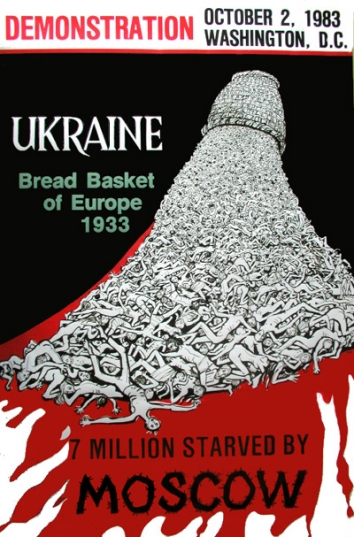Featured Galleries USUBC COLLECTION OF OVER 160 UKRAINE HISTORIC NEWS PHOTOGRAPHS 1918-1997
 Holodomor Posters
Holodomor Posters

Working capital performance improves in the US but stalls in Europe
 Ernst & Young, Kyiv, Ukraine, 6 June, 2012
Ernst & Young, Kyiv, Ukraine, 6 June, 2012
$1.2 trillion still tied up in working capital among leading companies
New York, 6 June 2012 — Working capital performance improved at U.S. companies, but leveled off at European companies in 2011 relative to 2010, with the key measure of cash-to-cash (C2C) dropping by 3% in the U.S. and remaining unchanged in Europe, according to All tied up 2012, Ernst & Young’s latest Annual Working Capital Management Survey.
Despite the modest improvement in the U.S. and relative stability in Europe for working capital performance, those surveyed – 2,000 of the largest companies by sales headquartered in the U.S. and Europe – still have an aggregate total of US$1.2 trillion in cash unnecessarily tied up in working capital. This is equivalent to nearly 7% of their sales, on par with the percentage from 12 months ago.
“While there are signs of corporate confidence in the global economy, businesses still remain cautious, said Steve Payne, Americas head of Working Capital Management at Ernst & Young. “Now’s the time for companies to reexamine their working capital management and employ effective strategies to either free up excess cash in order to return value to shareholders or fund growth in their company through M&A.”
Regional differences
The overall working capital performance gap between Europe and the US widened in 2011, reversing the tightening trend observed over the previous two years when Europe was closing the gap with the U.S. The US continues to exhibit much lower levels of working capital, driven primarily by strong performance in overall C2C (10% below that of Europe) and inventory (15% below that of Europe).
For the US, the overall improvement in C2C performance in 2011 arose from a combined reduction in receivables and inventories (DSO and DIO down 3% and 2%, respectively) which was partly offset by lower payables (DPO down 3%). In Europe, receivables and payables were marginally down (DSO and DPO each down 1%), while inventory was slightly up.
In Europe, companies saw a deterioration in C2C performance, with 48% reporting better C2C performance, a sharp decrease from 57% in 2010. A slightly higher proportion of companies posted improved receivables and payables (50% each) over improved inventory performance (42%).
A review of the largest companies across Asia, Australia & New Zealand, Canada, Central and Eastern Europe, Japan and Latin America reveals significant variations in working capital performance across regions. This is due to a number of factors including: industry bias, differing payment practices, supply chain infrastructures and focus on cash and process efficiency. Japan is the worst C2C performer among these regions and countries, while Australia & New Zealand (excluding Canada) score at the top of the ranking.
Performance by sector
In contrast to the previous two years, the gap in working capital performance between cyclical industries – such as automotive supply, chemicals, diversified industrials, semiconductors and steel – and noncyclical industries – such as food producers, food and general retailers and pharmaceuticals – narrowed in 2011 as cyclical industries returned to a more normal growth path on the heels of the global downturn in 2008.
As the gap between cyclical and noncyclical industries closed, the divergence in working capital results between the US and Europe across industries grew, driven by currency fluctuations and different growth patterns in the last quarter of the year. The working capital results of food producers, food and general retailers, pharmaceuticals, chemicals and semiconductors in Europe all fared significantly worse compared to their U.S. counterparts. However, the oil industry in both regions registered a significant improvement in WC performance.
Improving working capital management
While the total reduction in C2C achieved since 2002 is now 16% for both the U.S. and Europe combined, the rate of working capital improvement has been decelerating across geographies. In the past three years, C2C performance has stagnated in both regions, while average annual gains were approaching 3% in the previous six years.
While this global deceleration suggests that some opportunities for working capital improvements may have already been exploited, companies are reacting to challenging market conditions by increasing their focus on WC management and making aggressive inventory adjustments.
“With rising product complexity, high commodity prices and expansion into new geographic markets adding significant stress to the supply chain, companies need to take their working capital performance to a whole new level,” said Ed Richards, Principal, Working Capital Management at Ernst & Young. “Many companies only really focus on working capital metrics at key reporting periods such as quarter and year-end and miss out on huge potential cash gains by getting into a monthly or even weekly rhythm.”
About the survey
The Ernst & Young All tied up-working capital management report, contains the findings of a review of the working capital performance of the largest 2,000 companies (by sales) headquartered in the US and Europe. The analysis draws on companies’ latest fiscal 2011 reports. Performance comparisons have been made with 2010 and with the previous nine years. The review on which the report is based is segmented by region, country, industry and company.
About Ernst & Young
Ernst & Young is a global leader in assurance, tax, transaction and advisory services. Worldwide, our 152,000 people are united by our shared values and an unwavering commitment to quality. We make a difference by helping our people, our clients and our wider communities achieve their potential.
Ernst & Young expands its services and resources in accordance with clients’ needs throughout the CIS. 4000 professionals work at 18 offices in Moscow, St. Petersburg, Novosibirsk, Ekaterinburg, Kazan, Krasnodar, Togliatti, Yuzhno-Sakhalinsk, Almaty, Astana, Atyrau, Baku, Kyiv, Donetsk, Tashkent, Tbilisi, Yerevan, and Minsk.
Ernst & Young established its practice in Ukraine in 1991. Ernst & Young Ukraine now employs more than 500 professionals providing a full range of services to a number of multinational corporations and Ukrainian enterprises. For more information about our organization, please visit www.ey.com/ua.
This news release has been issued by Ernst & Young LLP, a member firm of the global Ernst & Young organization that also does not provide any services to clients in the US.











